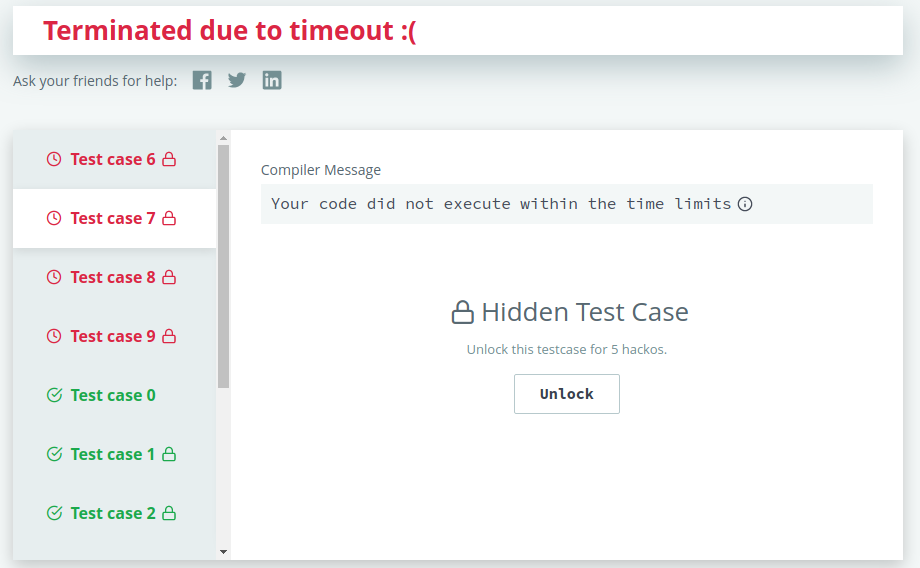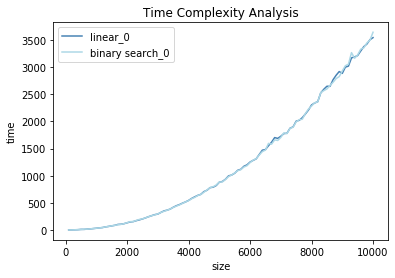1
2
3
4
5
6
7
8
#!/bin/python3
import sys
import numpy as np
import random, math
import logging, argparse, yaml, copy
import matplotlib.pyplot as plt
from utils.verbose import logging_time, printProgressBar
from collections import deque
1
2
3
4
5
6
7
8
9
10
toy_examples = \
"""7
100 100 50 40 40 20 10
4
5 25 50 120"""
msg = toy_examples
with open('input.txt', 'w') as f:
f.write(msg)
toy_examples
1
'7\n100 100 50 40 40 20 10\n4\n5 25 50 120'
Climbing the Leaderboard
Given scores, user’s scores, find ordered statistic array for each time step.
Note that
- given scores array is decreasing order.
- given scores array of a user is increasing order.
It means a rank of a score does not affect each other.
Therefore, it is not necessarily to update scores.
e.g.,
1
2
3
4
5
scores = [100, 90, 70, 50]
alice = 30, 60, 102
30 is 5-th order.
60 is 4-th order, which is lesser than previous rank 5.
102 is 1-th order, which is lesser than previous rank 4.
Also, when we find an order, only unique number is needed.
Key Idea
- At first, we need to make
scoresarray to be distinct numbers. This is because we can easily find ordered statistics. - Find each order from the distinct number, and then append it to
ans.
Linear Search
I used linear seach for the first approach.
Time complexity is as follows.
\(O(nm)\)
1
2
3
4
5
6
7
8
9
10
11
12
13
14
15
16
17
18
19
20
21
22
23
24
25
26
27
28
# Complete the climbingLeaderboard function below.
@logging_time
def solve1(scores, alice):
def linear(scores, x):
"""
1. find index, assume that scores are sorted by decreasing order.
2. insert x at right position.
3. update scores.
4. return ordered statistic. """
for i in range(len(scores)):
if x >= scores[i]:
if x > scores[i]:
scores = scores[:i] + [x] + scores[i:]
return i + 1
scores.append(x)
return i + 2
# make distinct
new_scores = [scores[0]]
for s in scores:
if s != new_scores[-1]:
new_scores.append(s)
scores = new_scores
ans = []
for x in alice:
ans.append(linear(scores, x))
return ans
1
2
3
4
5
6
7
8
9
10
11
if __name__ == '__main__':
# fptr = open(os.environ['OUTPUT_PATH'], 'w')
sys.stdin = open('input.txt')
n = int(sys.stdin.readline())
scores = list(map(int, sys.stdin.readline().split()))
m = int(sys.stdin.readline())
alice = list(map(int, sys.stdin.readline().split()))
result = solve1(scores, alice)
print(result)
1
2
([6, 4, 2, 1], 0.008344650268554688)
However, it is too slow.

How can this algorithm be faster?
At first, it is not necessarily to change scores array.
This is because given alice’s scores is ascending order.
As I mentioned before, a rank of a score does not affect each other.
we only find within front range more and more. Also, we don’t need to update scores array.
Binary Search
Secondly, I used binary search approach. It takes
\[O(mlogn)\]Please note that we should use binary search carefully!
This is because there are few exception we have to control in order to solve this problem.
Exceptions are as follows.
- the number
xis not exist inscores.- The first and the last order are explicitly handled.
- if
xis no way to be found from binary search recursion,s > ecase happend!1 2 3 4 5
if s > e: for i in range(e, s + 1): if scores[i] < x: break return i + 1
These code lines were hard to think for me.
1
2
3
4
5
6
7
8
9
10
11
12
13
14
15
16
17
18
19
20
21
22
23
24
25
26
27
28
29
30
31
32
33
34
35
36
37
38
@logging_time
def solve2(scores, alice):
def bs(scores, s, e, x):
# exceptions
if scores[0] < x:
return 1
if scores[-1] > x:
return len(scores) + 1
if s > e:
for i in range(e, s + 1):
if scores[i] < x:
break
return i + 1
# base case
elif s == e and scores[s] == x:
return s + 1
mid = (s + e) // 2
if scores[mid] < x:
return bs(scores, s, mid - 1, x)
elif scores[mid] == x:
return mid + 1
else:
return bs(scores, mid + 1, e, x)
new_scores = [scores[0]]
for s in scores:
if s != new_scores[-1]:
new_scores.append(s)
scores = new_scores
ans = []
last = len(scores) - 1
for x in alice:
if ans != [] and (0 <= ans[-1] <= len(scores)-1):
last = ans[-1]
ans.append(bs(scores, 0, last, x))
return ans
1
2
3
4
5
6
7
8
9
10
11
if __name__ == '__main__':
# fptr = open(os.environ['OUTPUT_PATH'], 'w')
sys.stdin = open('input.txt')
n = int(sys.stdin.readline())
scores = list(map(int, sys.stdin.readline().split()))
m = int(sys.stdin.readline())
alice = list(map(int, sys.stdin.readline().split()))
result = solve2(scores, alice)
print(result)
1
2
([6, 4, 2, 1], 0.009775161743164062)
Therefore, I could pass all test.
Analysis
To generate data simply, let n = m.
1
2
3
4
5
6
7
8
9
10
11
12
13
14
15
16
17
18
19
num_seed = 1
num_exp = 100
step, num_step = 1, num_seed*num_exp
seeds = [random.randint(0, 100) for _ in range(num_seed)]
for j, SEED in enumerate(seeds):
random.seed(SEED)
np.random.seed(SEED)
t1 = [[0]*num_exp for _ in range(num_seed)]
t2 = [[0]*num_exp for _ in range(num_seed)]
sizes = np.linspace(start=100, stop=10000, num=num_exp)
for i, size in enumerate(sizes):
size = int(size)
scores = sorted(list(np.random.randint(0, size*10, size)), reverse=True)
user = sorted(list(np.random.randint(0, size*10, size)))
ans1, t1[j][i] = solve1(scores, user)
ans2, t2[j][i] = solve1(scores, user)
assert ans1 == ans2
printProgressBar(iteration=step, total=num_step, msg="experiment...", length=50)
step += 1
1
|██████████████████████████████████████████████████| 100.0 % - experiment...
1
2
3
4
5
6
7
8
9
10
11
12
13
14
f, ax = plt.subplots(1,1)
colors = ['steelblue', 'peru', 'olivedrab', 'firebrick', 'darkolivegreen', 'darkblue', 'teal','coral',
'lightblue', 'lime', 'orange','darkgreen', 'lavender', 'tan', 'salmon', 'gold','darkred',
'turquoise','blue', 'green', 'red', 'cyan', 'magenta', 'yellow', 'black', 'purple', 'pink']
for i,j,k in zip(range(num_seed),t1,t2):
plt.plot(sizes, j, color=colors[i] , label='linear_{}'.format(i))
plt.plot(sizes, k, color=colors[i+8], label='binary search_{}'.format(i))
plt.xlabel('size')
plt.ylabel('time')
plt.title("Time Complexity Analysis")
plt.legend(loc='upper left')
plt.show()

Report
먼저 unique한 array를 만들고, linear search를 생각하는데 까지는 쉽게 성공했다. 그러나, binary search를 하는 과정에서 exception 처리하는 부분이 나에게는 처리하는데 힘들었고, 마침내 성공했다.
binary search 를 연습하기에 아주 좋은 문제였다. offical한 binary search code 는 이 링크에 따로 적어두었다.


Leave a comment